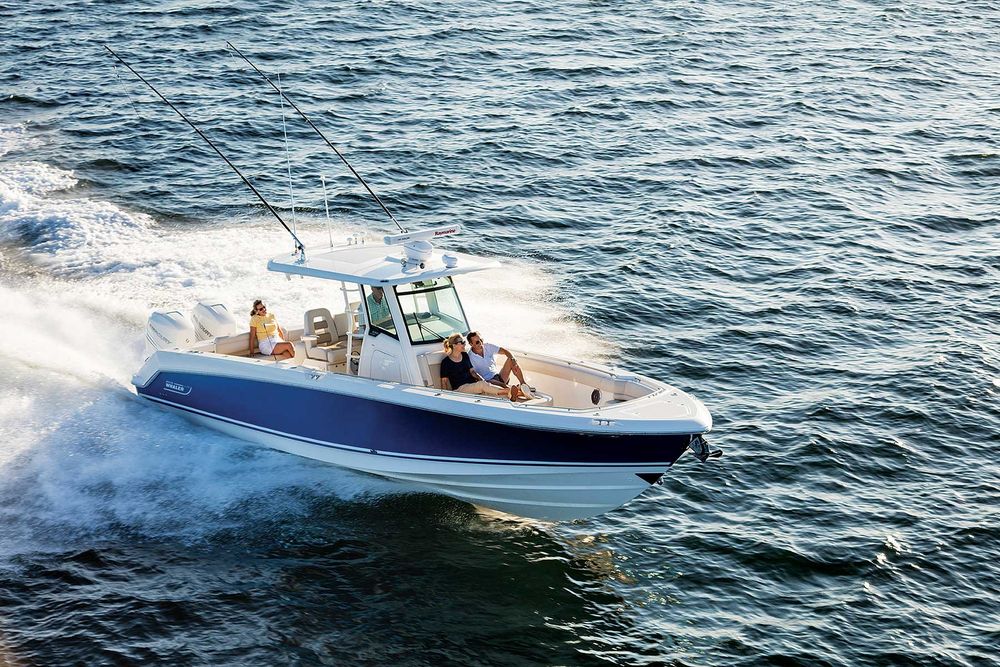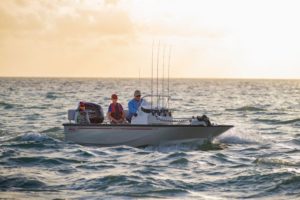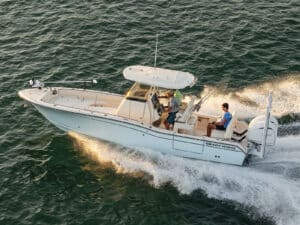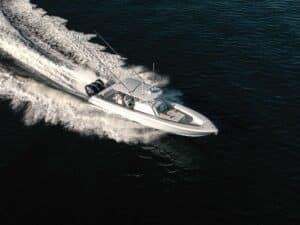
Fishing boats in the 23- to 26-foot range represent one of the most popular size categories today, and one for which many buyers face a decision — the choice between single or twin outboards.
Sometimes that decision proves easy. A number of models in this size range are not designed to handle or offered with twins, so a single is your only choice. Bay boats, for example, almost always feature single engines. With catamarans, twins are a virtual necessity. But with offshore V-hulls, the choice between singles and twins involves more consideration.
“This is a boat category for which many buyers need to look at the pluses and minuses of a single outboard versus twin outboards,” says Dean Corbisier, of Suzuki Marine. “Neither choice is a bad one, but there are considerations that can influence your decision one way or the other.”
Here are seven factors to keep in mind when choosing outboard power for a new V-hull in the 23- to 26-foot range.

Cost of the Boat Engine
Twins can more than double the cost of power. In addition, the cost for rigging — controls, wiring harnesses, cables, instrumentation, propping (sometimes not included with the engine) and labor — nearly doubles for twins, compared with a single outboard. Similarly, count on twice the cost of regularly scheduled maintenance for twin outboards versus a single.
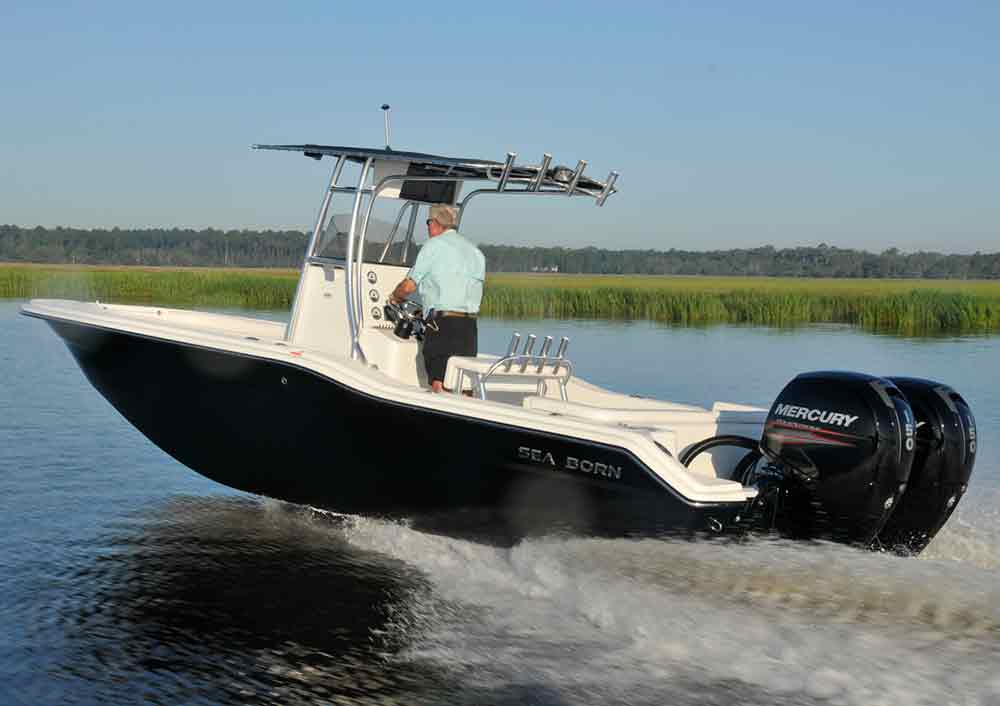
Boating Safety
A long-standing belief holds that twin-outboard boats are safer because you have a backup motor in case one breaks down. That way of thinking developed in the days when outboards were balky and prone to frequent problems, but that school of thought has lost much of its relevance thanks to the greater dependability of today’s outboards.
“The reliability of today’s outboards is better than ever before,” says Corbisier. “With the way outboards perform now, no boating angler should be hesitant to venture offshore with a single outboard.
“Many of our Suzuki pros have fished offshore with single outboards for years.”
Still, twins slightly edge out a single motor when it comes to getting home under your own power in the unlikely event of a breakdown. However, when engine failures are related to fuel problems, such as phase separation from ethanol-laced gasoline blends, twins don’t offer much of an advantage.
“If twin engines are pulling fuel from the same tank, the bad gas will likely affect both of them,” Corbisier says.

Boat Speed
All things being equal, including horsepower and weight of the hull, a single outboard should come out ahead when it comes to speed, because a single gear case and propeller create less drag in the water than two.
In addition, the weight of two smaller outboards usually exceeds the weight of one large motor. To give you an idea, a Yamaha F250 has a published weight of 619 pounds, while a pair of Yamaha F115s has a combined weight of 772 pounds (386 pounds each). That extra mass can adversely affect top speed.
For evidence, we looked at Yamaha’s performance bulletins for the Key West 244CC, which was tested with a wide range of power configurations, including a single F250 and twin F115s. The single 250 achieved a top speed of 45.2 mph versus 43 mph for a pair of 115s, owing to the extra weight of the twins, as well as to their slightly lower overall horsepower.
Although that bulletin helps illustrate the point, another indicates that a single might not always be faster. In comparing the performance of the same boat model powered by a Yamaha F300 against a pair of Yamaha F150s, the twins posted the better speed of 53.6 mph versus 49.5 mph for the single. While a single should be faster, factors such as propping and engine height can affect the top speed of either setup.
In real life, many twin installations offer horsepower that far exceeds a single outboard. Instead of twin 150s, for example, many buyers opt for twin four-cylinder 200s. There is little or no extra weight for this upgrade, yet it gives the boat an additional 100 hp that should result in a big top-speed advantage over the single 300.
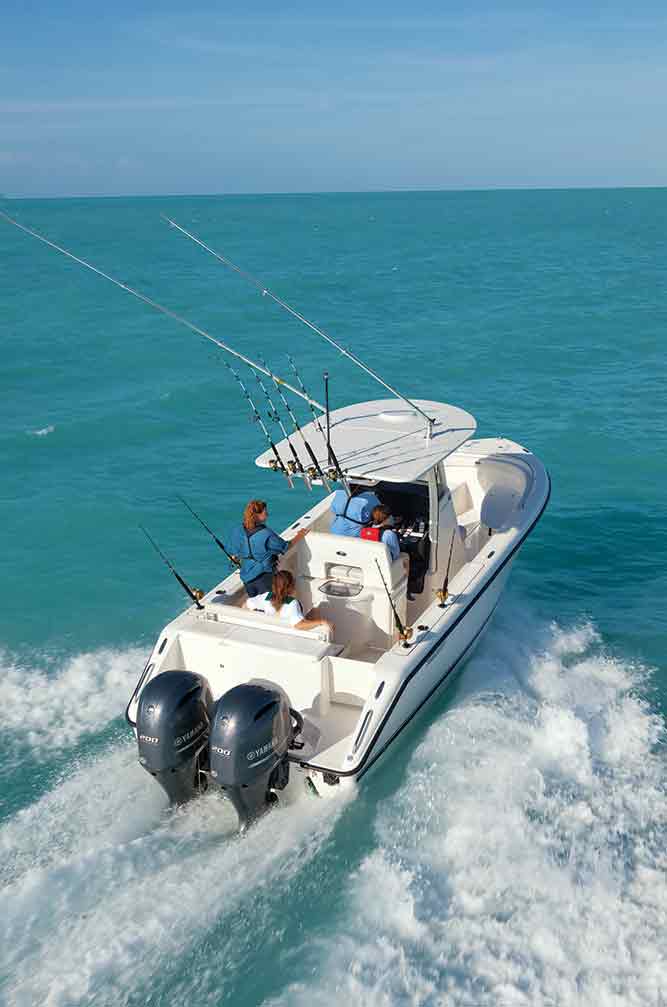
Speed of Hole Shot
As with top speed, acceleration times can vary, but generally speaking, twin outboards should achieve a quicker hole shot than a single outboard of the same horsepower. This is because twins have greater blade area with which to punch out of the hole, and drag is less of a factor during initial acceleration than at higher velocities.
With the Key West 244 cited above, the twin 115s vaulted to 30 mph in 5.57 seconds, while the single 250 took 8.97 seconds to reach the same speed. The twin 150s attained 30 mph in 5.42 seconds, and the single 300 took only slightly longer, 5.61 seconds.
Fuel Efficiency of the Boat
If your goal is maximum miles per gallon, choose a single outboard. Again, it boils down to less drag and weight than with twin engines, assuming all other factors are equal. In Yamaha’s performance testing with the Key West 244CC, the single F250 achieved 3.15 mpg at 26.1 mph versus 3.03 mpg at 22.4 mph with twin F115s. In the second test, the single F300 posted its best performance of 3.98 mpg at 22.7 mph versus 3.11 mpg at 20.5 mph with the twin F150 outboards.
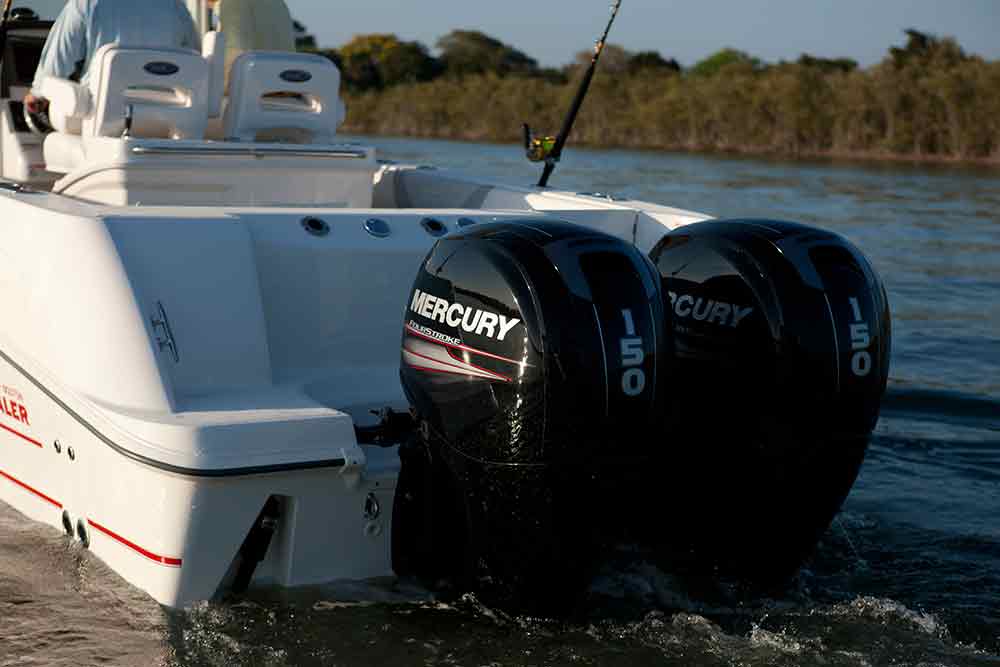
Easier Boat-Engine Setup to Use
Synchronizing the revolutions per minute and trim angles for twin outboards was once a tedious chore, but advances in electronic engine controls have eased the task of running multiple outboards. Although all twin engines come with twin throttle/shift levers, new systems permit control of revolutions per minute and trim for both motors with just one lever and trim switch while underway.
Power-assist hydraulic steering systems, such as Optimus from SeaStar Solutions, also let you steer multiple outboards with a light touch — literally one finger. Yamaha offers power assist as part of its Helm Master system, and all Mercury Verado outboards come standard with power steering. Gone are the days when you had to wrestle with the wheel to turn the motors. As a result, twin outboards are now just as easy to run as a single engine.

Boat Handling
With an effective pair of directional thrust vectors in the form of outboard lower units, twins win the maneuverability contest, hands down. In the right hands, a twin-engine boat can spin in place on its center point like a pinwheel, turn very sharply without swinging the stern in tight alleyways, or “walk” sideways to sidle up to a dock. That’s not to say that single-outboard boats lack maneuverability, but a twin gives you the edge when trying to jockey a boat around in tight quarters.
Some twin-engine setups also make possible the addition of a joystick docking-control system, such as Mercury’s Joystick Piloting for Outboards, SeaStar Solutions’ Optimus 360 or Yamaha’s Helm Master, for the ultimate in low-speed maneuverability.
Weigh all these factors carefully if you’re in the market for a new outboard-powered V-hull in the 23- to 26-foot range, then choose the power configuration that best suits your mindset, primary type of fishing and style of boating.
